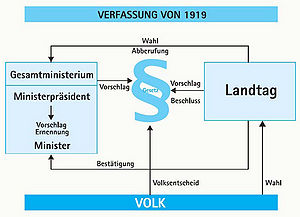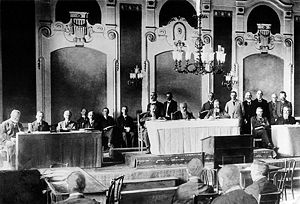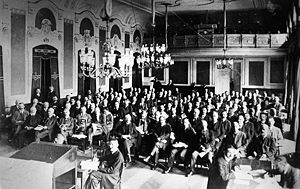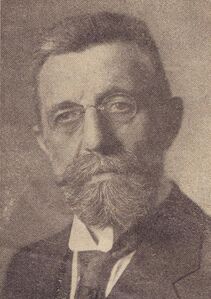


After the coup in November 1918, the revolutionary Eisner government faced the challenge of creating a new constitution. Due to a lack of its own constitutional experts, in the same month, it commissioned representatives of the old elite, the expert in constitutional law Robert Piloty (1863-1926) and the Ministerial Councillor Josef von Grassmann (1864-1928), to draw up a constitution for the "People's State of Bavaria". Their draft remained decisive for further development, although parliamentary deliberations were delayed as a result of the revolutionary unrest in Bavaria from February to April 1919. The actual work by the Landtag did not begin until May 1919 in Bamberg. It ended with the adoption of the constitution on 12 August 1919. It came into force on 15 September 1919. It was based on the principles of a parliamentary representative democracy. The idea of worker’s councils, which played a major role in the time of its origin, was hardly included at all. The constitution stipulated a strong state parliament and refrained from creating a bicameral system. The Minister President had a comparatively weak position in the government. The constitution had a concise catalogue of basic rights and, for the first time in Germany’s history, it granted individual citizens the right to lodge a constitutional complaint. In 1933, the so-called Bamberg constitution was effectively repealed. It was formally repealed by the 1946 Constitution.
The first phase of the constitutional process
The development process of the Bavarian constitution from 14 August 1919, also known as the "Bamberg constitution" after the place where it was adopted, can be formally divided into two clearly distinguishable phases: the first – extra-parliamentary – phase of the constitution's development, which was characterised by a multitude of upheavals, disruptions, unintended consequences of action and unforeseeable development dynamics, began, in a way, with the Munich coup of 7/8 November 1918 and the first programmatic rallies of the Eisner government over the next few days. These clearly expressed the intention to initiate a new arrangement of the normative foundations of Bavarian state life as soon as possible, although the details of this arrangement were not specified at this point.
The actual beginning was marked by the decision by the Council of Ministers on 18 November 1918 to appoint a "Commission of Lawyers" to prepare the corresponding drafts. They came to this decision not least due to significant shortcomings regarding constitutional law and policy. These were evident not only in the two socialist parties that formed the government, but also in the other parties and other politically relevant forces in the country. With Ministerial Councillor Josef von Graßmann (1864-1928), Professor Robert Piloty (DDP, 1863-1926) and three other high-ranking ministry officials from the foreign and finance departments, representatives of the old elites in state administration and jurisprudence, all of whom were in the tradition of political liberalism, were commissioned to draft a new constitution. In the following weeks, Graßmann and Piloty, both students of the old master of Bavarian constitutional law, Max von Seydel, created the first drafts of a republican constitution for the " People's State of Bavaria ". In principle, these already contained all the key structural elements and characteristics of the final constitutional reorganisation, and above all a clear commitment to representative democracy. Despite some concrete guidelines from the Council of Ministers, both lawyers had considerable leeway. Minister President Kurt Eisner (USPD, 1867–1919) in particular, who gradually moved away from the originally envisaged quick constitutional process, only exerted selective influence on the content of the new Bavarian constitution.
A first significant break in the process of constitutional reorganisation was the first Staatsgrundgesetz (State Basic Law) of 4 January 1919, which was enacted on Eisner's initiative and which was to lay down the fundamental principles of the future Bavarian constitution. Its creation through an octroi by the government and some legally highly problematic regulations, such as the provisional transfer of legislative power to the revolutionary government (para. 17), provoked massive public opposition.
The notably surprising results of the state elections on 12 January and 2 February 1919, in which Eisner's USPD suffered a crushing defeat with just 2.5 % of the vote and the bourgeois parties won the majority of the seats, had to be seen as a clear plebiscite in favour of a parliamentary democracy. From this point on, at the latest, the balanced combination of council-democratic and representative elements in the new constitutional order, which Eisner had called for so emphatically, could no longer appear to be a realistic option. In the period that followed, however, Eisner's delaying tactics, the efforts of the councils and their central bodies to ensure that they were adequately represented in the constitution, and the efforts of the Bavarian government to influence the creation of a constitution at Reich level in a federalist sense, slowed down the final reorganisation of the constitutional situation in Bavaria. The political radicalisation that followed the attacks of 21 February 1919 and the extensive paralysis of government activity then caused work on the new Bavarian constitution to stagnate almost completely. However, the second provisional State Basic Law of 17 March 1919 did at least bring into force a new transitional constitution in accordance with general democratic principles and the rule of law.
The second phase of the constitutional process
The second – parliamentary – phase of the constitution's development began after the final military suppression of the rule of the worker’s councils, when the state parliament sessions began again on 15 May 1919 in Bamberg, where the government and the state parliament had retreated to in the face of the unrest in Munich. The state government led by Johannes Hoffmann (SPD, 1867–1930) now modified the constitution’s first draft, which had been on the table since mid-February, in line with the amendments and additions proposed by the ministries. The resulting government draft of a "Constitutional Charter for the Free State of Bavaria" was sent to the state parliament on 28 May 1919, which immediately forwarded it to its constitutional committee. Under the decisive leadership of the consultants Friedrich Ackermann (SPD, 1876–1949), Heinrich Held (1868–1938, BVP) and Robert Piloty, this committee deliberated over the government bill in depth between mid-June and early August 1919. This led to numerous changes, the majority of which were not substantial.
Several factors had a positive impact on the progress of the negotiations. For example, just before the committee meetings began, on 30 May 1919, a government alliance of MSDP, BVP and DDP was formed with the "Bamberg Agreement" in line with the Weimar Coalition at the Reich level. Through this agreement, consensus was also reached on the broad outlines of future constitutional policy. Added to this were the specific local conditions in Bamberg, which contributed decisively to a calm, factual and results-oriented atmosphere. This was characterised by a high degree of willingness from the relevant stakeholders to cooperate, especially when compared with parliamentary practice in later years. It also proved advantageous that the actual creators of the government draft, Graßmann (as government commissioner) and Piloty (as a member of parliament), met again during the committee negotiations. The committee, whose deliberations were largely influenced by the parallel constitutional deliberations of the Weimar National Assembly, was therefore able to complete its work within a relatively short period of time. The state parliament plenum passed the new Bavarian constitution as early as 12 August 1919, two days before the Weimar Reichsverfassung (WRV – Weimar Constitution) came into force, with just three votes against (by the USPD) and one abstention.
After being signed by the President of the State Parliament and the Gesamtministerium (government) on 14 August 1919, and after one last edit to the text to align it with the Reich's constitution, the constitutional charter finally came into force on 15 September 1919, when it was published in the Gesetz- und Verordnungsblatt für den Freistaat Bayern (Law and Ordinance Gazette for the Free State of Bavaria. Until 1933, the Bamberg constitution formed the decisive basis of state life in Bavaria without undergoing any major changes. It was suspended in practice under the conditions of the Nazi dictatorship, although it was only formally repealed by the Bavarian Constitution of 1946.
-
Dr Joseph von Graßmann (1864-1928). Fig. from: Das Bayerland, volume 33 from Februar 1922, 174. (Bayerische Staatsbibliothek, 4 Bavar. 198 ta-33)
-
Robert Ferdinand Piloty (1863-1926). As a member of the Bavarian State Parliament (DDP) in 1919, the jurist played a decisive role in the drafting of the Bavarian constitution. (from: Bayerischer Landtag [pub.], Amtliches Handbuch des Bayerischen Landtags, Munich 1920, 187. Bayerische Staatsbibliothek, Bavar. 4339 h-1920)
The substantive content of the constitution
The Bavarian constitution of 1919 is in the classic liberal-democratic traditions of the right of reason, the Enlightenment, the French Revolution and the revolution of 1848. It consistently implements the principles of a parliamentary representative democracy under the unmistakable influence of Western European models.
A characteristic feature of this is the extremely strong position of the Landtag (state parliament), which was elected by general, equal, secret and direct (proportional) elections, and which was sometimes even described as "sovereign" in the constitutional deliberations. It was entrusted with exercising all rights of state authority, unless they were explicitly reserved for citizens or other bodies (Article 3(1) of the Bavarian Constitution [BV]). In addition to the entire field of legislation (including constitutional legislation), it was responsible in particular for the approval of all state treaties and regulations concerning the establishment of authorities, the approval of state income and expenditure, the right to set up committees of inquiry and, last but not least, the appointment and dismissal of the government or its members (Articles 44-56 BV).
On the other hand, the installation of a second chamber of parliament was avoided, definitely with the restrictions under the law of the Reich as stipulated in the so-called homogeneity clause of Article 17(1) of the WRV in mind. Only the option of setting up professional representations with greatly reduced competences "to carry out the economic and social tasks of all creative circles of the people" – in the sense of a last relic of the idea of worker’s councils – was included in the constitution (Article 24 BV).
The highest executive body of the state was the Gesamtministerium (Article 4(1) BV), to which the management of the entire state administration, the execution of the law, the representation of Bavaria vis-à-vis the Reich and other states, the right to appoint civil servants and to supervise their service, the enactment of legal and administrative regulations, the preparation and presentation of the budget (Articles 57, 61 BV) as well as the handling of the emergency law (Article 64 BV) (which was ultimately extremely important in the constitutions practice) were transferred in particular. In regards to the internal organisation of the Ministry as a whole, the principle of collegiality was applied consistently and the bulk of the state's management powers were transferred to the whole government. The individual departmental ministers, who could be assisted by state secretaries as permanent political representatives (Article 58(2) BV), were only given relatively limited powers. Accordingly, the Minister President, who was elected by the state parliament with a majority of its statutory number of members and whose office de jure was only created by the "Bamberg Constitution", merely had the position of a "primus inter pares" (Article 62 BV) within the government and actually had no authority to issue political directives.
Meanwhile, the option of introducing the office of a State President, opened up in principle by the Reich Constitution and suggested by the conservatives, was not availed. The main reason was probably the fear that such a personal head of state would favour a restoration of the monarchy.
Although the legal institutions of the referendum process and referendum vote were also formally introduced, in view of the great scepticism regarding the people's political maturity, it was made so difficult to exercise them by imposing high participation and voting quorums that they could hardly be of any practical significance (Article 7(1), Article 10 BV).
In accordance with the repeatedly articulated claim to create a "full Bavarian constitution" and not a mere organisational statute, the constitution contained an – albeit greatly reduced – catalogue of fundamental rights; it was limited to formulating some supplementary state law regulations in addition to the fundamental rights of the Reich, which tellingly only applied to "Bavarian citizens" to their full extent. As a result, protection against expulsion from the state territory, the right of free movement, the general principle of equality, in the context of which the "abolition" of the nobility was explicitly decreed, the freedom of person and property as well as the full freedom of belief and conscience were enshrined in the constitution as separate "Bavarian" basic rights (Articles 13-16, 17(1) BV).
Added to this were detailed regulations on the relationship between state and church, which, in conjunction with the corresponding provisions of the Reich constitutional law, finally abolished the previous system of a Bavarian state-church and the state-church’s associated sovereignty (Articles 17-19 BV). Lastly, one specifically Bavarian outlier was the legal institution of the constitutional complaint to the Bavarian State Court of Justice, which was granted to all citizens and legal persons based in Bavaria in the sense of an additional protection of constitutional law, which was quite relevant in practice (Article 93 BV).
Importance of the constitution
If one takes into account the political framework of its origin, which was extremely problematic in comparison with developments in most other German states, the relatively narrow limits set by the prejudicial provisions of the Reich Constitution and the views on constitutional law prevailing at the time, the Constitution of the Free State of Bavaria of 14 August 1919 can certainly be regarded as a remarkable constitutional achievement for its time. The constitution, which, apart from a few minor changes and temporary breakthroughs, was to retain its original form regardless of all reform discussions, provided a firm and reliable foundation for a state life exposed to manifold burdens until 1933. In doing so, it self-confidently expressed the claim to maintaining Bavarian statehood and undoubtedly accomplished independent, innovative solutions. It must also be taken into account that the Bamberg constitution had a decisive influence on the content of the Bavarian constitution valid today, not least because of close personal links. The 1946 constitution adopted several of its predecessor's basic values and core elements and, taking historical experience into account, consequently developed them further. Situated at a crossroads where two systems met, the Bamberg constitution was therefore a key milestone on Bavaria's path to becoming a free and democratic constitutional state based on the rule of law and a modern constitution, as it exists since 1945.
References
- Thomas Bock, Das Grundrechtsverständnis des Bayerischen Staatsgerichtshofs nach der Verfassungsurkunde des Freistaates Bayern vom 14. August 1919 und das zeitgenössische Schrifttum (Theorie und Forschung. Rechtswissenschaften 90), Regensburg 2001.
- Wolfgang Ehberger, Bayerns Weg zur parlamentarischen Demokratie. Die Entstehung der Bamberger Verfassung vom 14. August 1919 (Studien zur bayerischen Verfassungs- und Sozialgeschichte 29), München 2013.
- Gerhard Heyl (Bearb.), Reich und Länder in der Weimarer Republik (Ausstellungskataloge der Staatlichen Archive Bayerns 3), München 1970.
- Hans-Michael Körner, Bamberg. Die Verfassung von 1919, in: Alois Schmid/Katharina Weigand (Hg.), Schauplätze der Geschichte in Bayern, München 2003, 354-368.
- Ariane Mittenberger-Huber, Das Plebiszit in Bayern. Eine rechtshistorische Bestandsaufnahme (Schriften zur Rechtswissenschaft 42), Bayreuth 2000.
- Karl Möckl, Monarchie und Republik Bayern. Zur Bedeutung der Bamberger Verfassung 1919, in: Theo Stammen (Hg.), Politik - Bildung - Religion. Hans Maier zum 65. Geburtstag, Paderborn u. a. 1996, 177-196.
- Christian Georg Ruf, Die bayerische Verfassung vom 14. August 1919 (Schriften zum Landesverfassungsrecht 4), Baden-Baden 2015.
- Werner Wagenhöfer/Robert Zink (Hg.), Räterepublik oder parlamentarische Demokratie. Die "Bamberger" Verfassung 1919. Begleitband zur gleichnamigen Ausstellung des Staatsarchivs Bamberg und des Stadtarchivs Bamberg vom 23. September bis 19. November 1999 im Stadtarchiv Bamberg (Veröffentlichung des Stadtarchivs Bamberg 10), Bamberg 1999.
- Hanne Zech, Das Verhältnis zwischen Parlament und Regierung in der Bamberger Verfassung, Bayreuth 1993.
Sources
- Wolfgang Ehberger/Johannes Merz (Bearb.), Das Kabinett Hoffmann I. 17. März - 31. Mai 1919 (Die Protokolle des Bayerischen Ministerrats 2/I), München 2010.
- Wolfgang Ehberger (Bearb.), Das Kabinett Hoffmann. 2. Band, 1. Teil: 31. Mai - 1. September 1919 (Die Protokolle des Bayerischen Ministerrats 2/II,1), München 2017.
- Heinrich von Jan, Die Verfassungsurkunde des Freistaates Bayern vom 14. August 1919, München 1927.
- Jakob Kratzer, Die Verfassungsurkunde des Freistaats Bayern vom 14. August 1919, München/Berlin/Leipzig 1925.
- Ernst Müller-Meiningen, Aus Bayerns schwersten Tagen. Erinnerungen und Betrachtungen aus der Revolutionszeit, Berlin/Leipzig 1923.
- Hans Nawiasky, Bayerisches Verfassungsrecht, München 1923.
- Robert Piloty, Die bayerische Verfassung vom 14. August 1919, in: Jahrbuch des öffentlichen Rechts der Gegenwart IX (1920), 129-162.
- Alfons Wenzel, Bayerische Verfassungsurkunden, Stamsried 4. Auflage 2002.
- Fabian Wittreck (Hg.), Weimarer Landesverfassungen. Die Verfassungsurkunden der deutschen Freistaaten 1918-1933, Tübingen 2004.
Further Research
Related Articles
- Grundrechte in der bayerischen Verfassungsgeschichte
- Wahlrecht (Weimarer Republik)
- Weimarer Reichsverfassung, 1919
Verfassung von 1919, Bamberger Verfassung
Cite
Wolfgang Ehberger, Constitution of the Free State of Bavaria (1919), published 23 August 2017, English version published 22 March 2024; in: Historisches Lexikon Bayerns, URL: <https://www.historisches-lexikon-bayerns.de/Lexikon/EN:Constitution_of_the_Free_State_of_Bavaria_(1919)> (21.12.2025)


![Robert Ferdinand Piloty (1863-1926). As a member of the Bavarian State Parliament (DDP) in 1919, the jurist played a decisive role in the drafting of the Bavarian constitution. (from: Bayerischer Landtag [pub.], Amtliches Handbuch des Bayerischen Landtags, Munich 1920, 187. Bayerische Staatsbibliothek, Bavar. 4339 h-1920)](/images/thumb/7/77/Robert_Piloty_1920.jpg/221px-Robert_Piloty_1920.jpg)